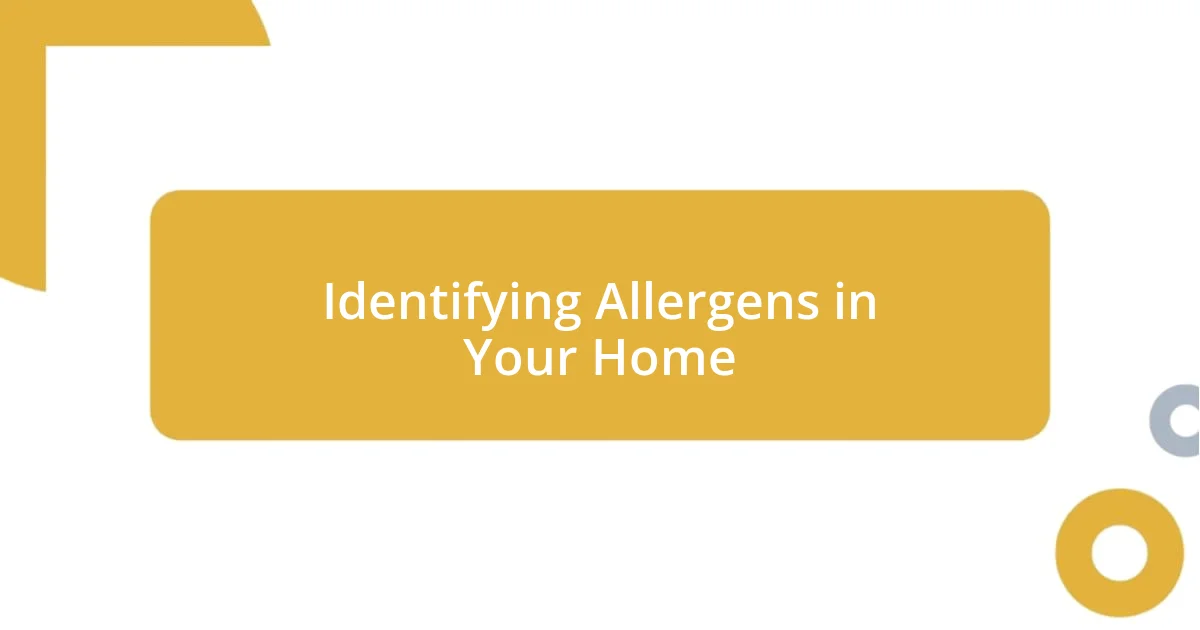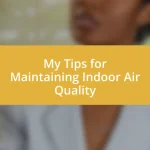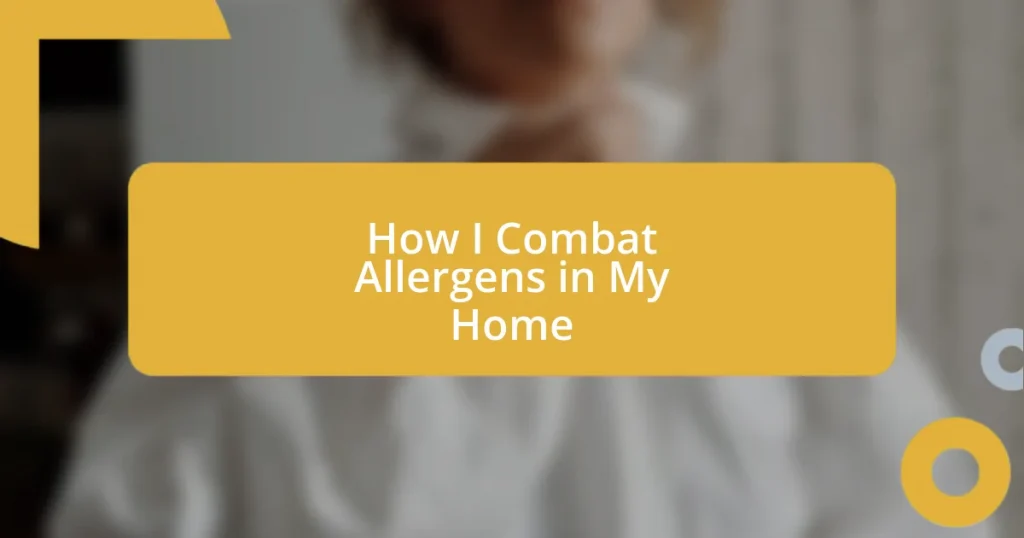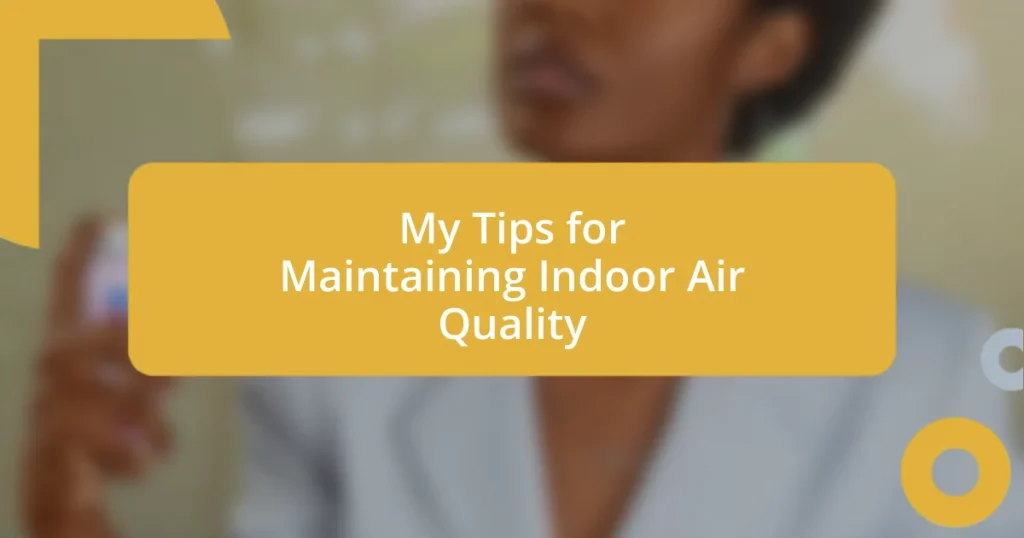Key takeaways:
- Common indoor allergens include dust mites, pet dander, and mold, which can be managed through regular cleaning and monitoring.
- Investing in hypoallergenic products, air purifiers, and natural cleaning solutions can significantly improve indoor air quality and reduce allergy symptoms.
- Maintaining a routine for vacuuming, checking humidity levels, and monitoring potential allergens helps create a proactive environment for allergy sufferers.

Understanding Common Indoor Allergens
When I think about indoor allergens, I can’t help but remember the sneezing sprees I went through as a child. Dust mites, microscopic creatures that thrive in our bedding and upholstery, are often the culprits. It’s astonishing to consider that a single gram of dust can host thousands of these tiny irritants—how can something so small cause such big reactions?
Pet dander is another common offender, especially if you’re a pet lover like I am. I adore my cat, but I’ve realized that keeping her fur under control is essential. Every time I notice a fresh batch of hair on the couch, I wonder, “Is this what’s triggering my allergies today?” It’s a constant battle that requires vigilance and a bit of creativity to manage.
Mold, with its musty smell, can sneak up on you in damp areas of your home. I’ve found that simply keeping an eye on the bathroom and kitchen can save me from those allergic reactions. It’s a reminder that sometimes, the simplest solutions, like keeping windows open for ventilation, can make a significant difference in combating allergens. Don’t you think it’s worth the effort for a more comfortable living space?

Identifying Allergens in Your Home
Identifying allergens in your home is a crucial step toward creating a healthier environment. I often start by inspecting hidden areas, like behind furniture or under the bed, where allergens like dust and pet hair tend to accumulate. Once I’m aware of these hotspots, I can address them more effectively—it’s all about knowing where to look!
On a different note, I’ve discovered the importance of using a good air quality monitor in my home. Just last month, I noticed a spike in particulate matter, which had me wondering if mold was lurking somewhere. After a little digging, I found a small patch in a corner of the bathroom. Addressing this not only improved the air quality but also stopped those surprise allergy flare-ups I’d been experiencing.
Lastly, taking note of seasonal changes helps me stay ahead of outdoor allergens that can sneak their way inside. When the pollen count is high, I close the windows and run the air conditioning to filter out those pesky particles. It reminds me of the little measures I can take to enjoy my home without worrying about sneezes and itchy eyes.
| Allergen Type | Common Sources |
|---|---|
| Dust Mites | Bed linens, upholstery, carpets |
| Pet Dander | Animal fur, skin flakes |
| Mold | Bathrooms, kitchens, damp areas |

Effective Cleaning Strategies for Allergens
I can’t stress enough how vital effective cleaning strategies are in my battle against allergens. One method I swear by is using a high-efficiency particulate air (HEPA) vacuum. This vacuum captures the tiniest particles, and I always feel a sense of relief after I see how much dust and pet hair it collects. It’s that moment when I realize I’ve just tackled an unseen enemy lurking in my home.
To keep my living space allergen-free, I follow a routine that includes:
- Washing bedding weekly in hot water.
- Using allergen-proof mattress and pillow protectors.
- Dusting surfaces with a damp cloth to trap dust rather than spreading it.
- Regularly washing my cat’s favorite spots to minimize dander.
- Cleaning hard floors with a microfiber mop to pick up debris effectively.
Each of these actions not only helps reduce allergens but also cultivates a comforting environment—like giving my home a fresh breath of air. It feels great to know I’m creating a sanctuary for both myself and my furry friend.

Choosing Allergen-Reducing Home Products
Choosing the right home products can make a remarkable difference in reducing allergens around us. I remember when I switched to a fragrance-free laundry detergent after realizing that strong scents were triggering my allergies. Not only did my clothes feel fresher, but my breathing improved as well— it’s incredible how the little changes lead to a healthier atmosphere!
I find that investing in hypoallergenic bedding is essential for a good night’s sleep. When I purchased my first set of these specially designed sheets, I was surprised by how soft they felt. After just a week, I noticed fewer morning allergy symptoms. It made me wonder: why didn’t I do this sooner? The comfort and relief I experienced were truly worth it.
Beyond bedding, selecting home cleaning products that utilize natural ingredients has been a game changer. For example, I’ve shifted to vinegar and baking soda for most of my household cleaning needs, which not only cut down on chemical exposure but also felt safer for my pets. Have you ever tried cleaning with these simple solutions? The satisfaction of a clean home without harsh chemicals is profoundly fulfilling!

Implementing Air Quality Improvements
Implementing improvements to my home’s air quality has been eye-opening. I invested in a portable air purifier, and I can’t overstate how it transformed my living space. The first time I turned it on, I could practically feel the difference in the air. Have you ever noticed that clearer feeling when stepping outside? That’s what I experienced indoors for the first time. It’s like an invisible shield against allergens, and I find myself breathing easier as a result.
Another change I made was switching to house plants known for their air-purifying qualities. I added spider plants and peace lilies to my living room, and to my delight, they turned out to be low-maintenance companions. Whenever I walk by, I feel a sense of connection to nature that’s soothing. Plus, did you know that they can help filter out common indoor pollutants? It gives me peace of mind knowing that my home is not only a refuge but also a healthier environment.
Don’t underestimate the importance of regular filter changes in your heating and cooling system. Initially, I overlooked this simple task. But after noticing a decline in air quality, I started replacing filters every three months, and what a relief it was! The freshness that permeated my home was noticeable, almost like a gentle breath of fresh air. Have you experienced that refreshing feeling after a good deep clean? It can make a world of difference in how you feel at home.

Maintaining Prevention and Monitoring Practices
Maintaining proactive practices around allergen prevention has become a part of my daily routine. For instance, I make it a habit to vacuum my floors and upholstery at least twice a week. It’s surprising how much dust and pet dander can accumulate in such a short time! Have you ever seen the difference after a thorough cleaning session? The instant clarity in the air is almost euphoric for someone like me with allergies.
To further fortify my efforts, I regularly check humidity levels around my home. I invested in a digital hygrometer, and honestly, that small device has become a game changer. Keeping humidity around 30-50% not only helps prevent mold growth but also contributes significantly to my comfort. I still remember the relief I felt after making those adjustments; it’s like fine-tuning an instrument to play a symphony of health in my living space.
Routine monitoring of potential allergens is an essential aspect that I can’t overlook. Every month, I go through a checklist— inspecting areas prone to mold, assessing any new products I introduce, and even observing my family for allergy symptoms. This practice has given me the confidence to tackle issues before they escalate. Have you ever noticed how a little vigilance can lead to big rewards? In my experience, staying ahead of allergens is about building a lifestyle that embraces prevention instead of simply reacting when symptoms arise.















